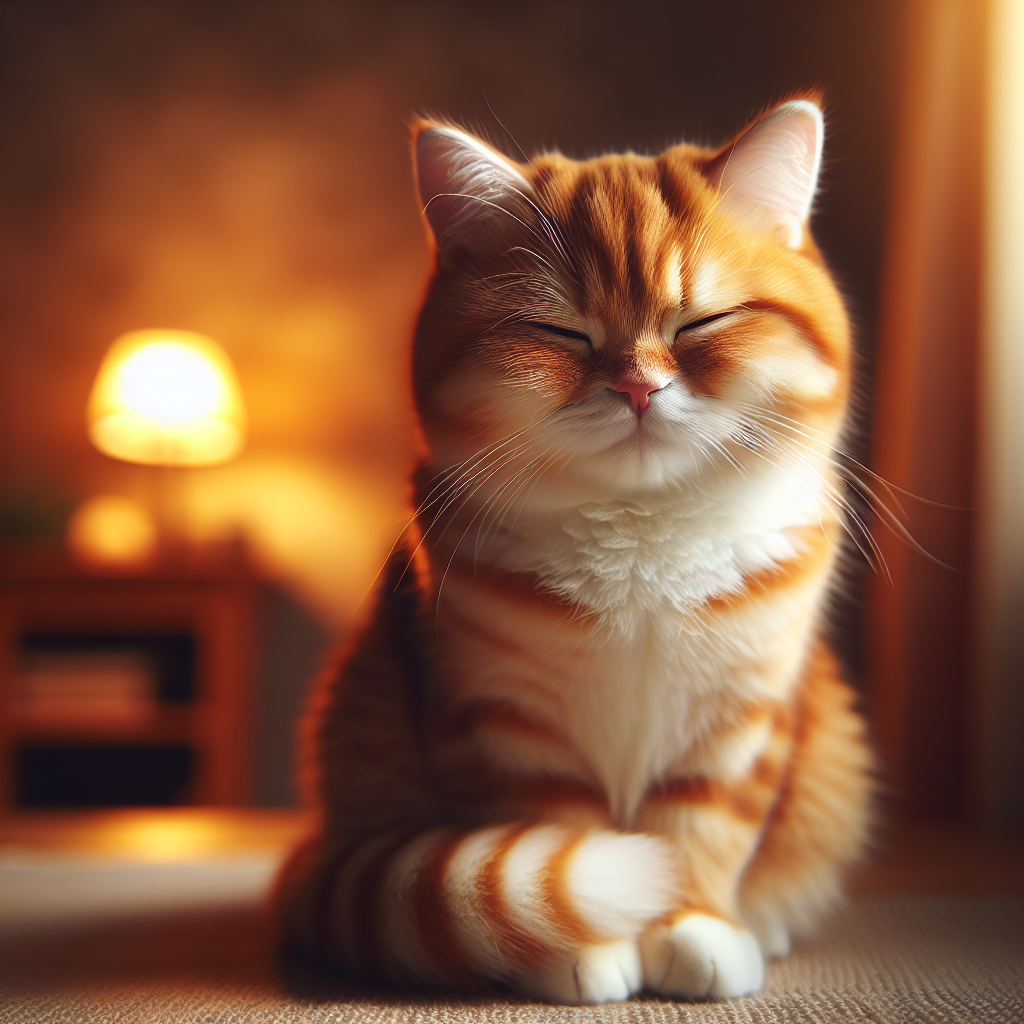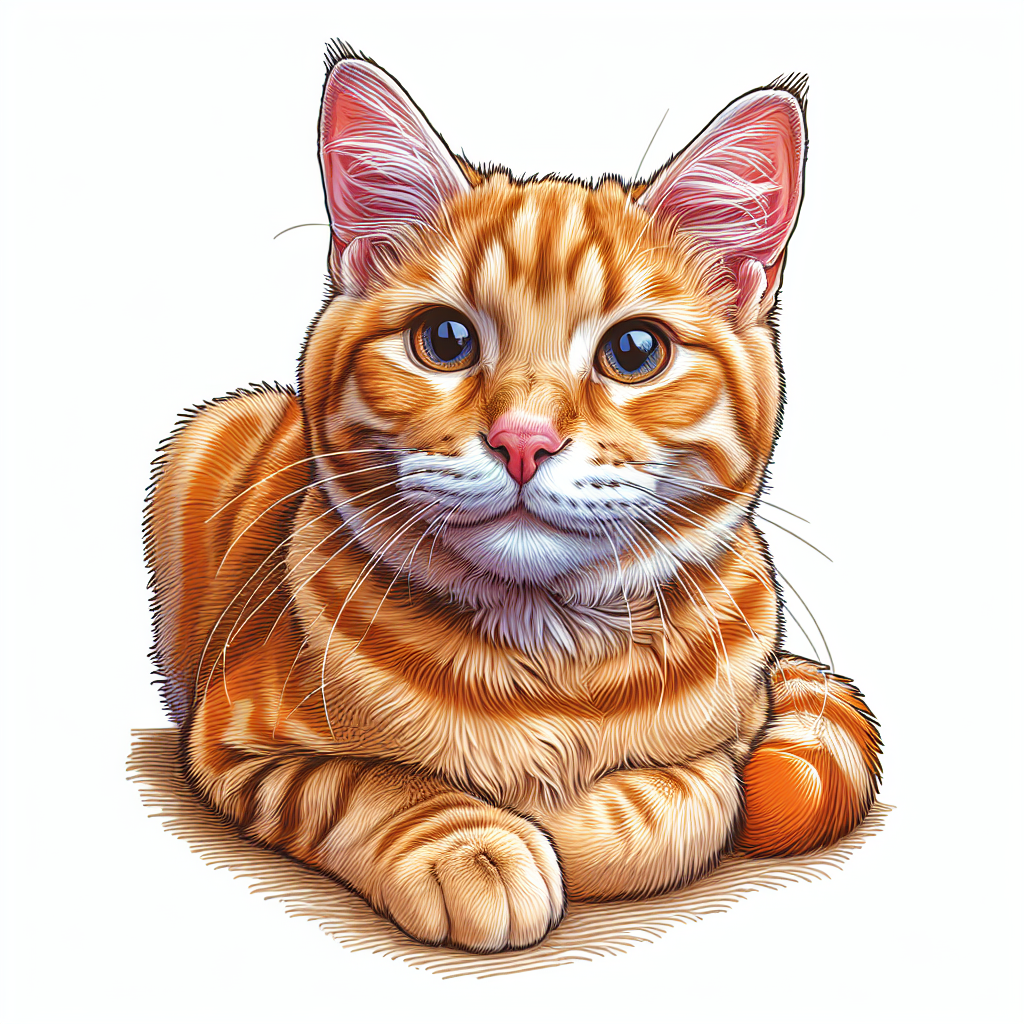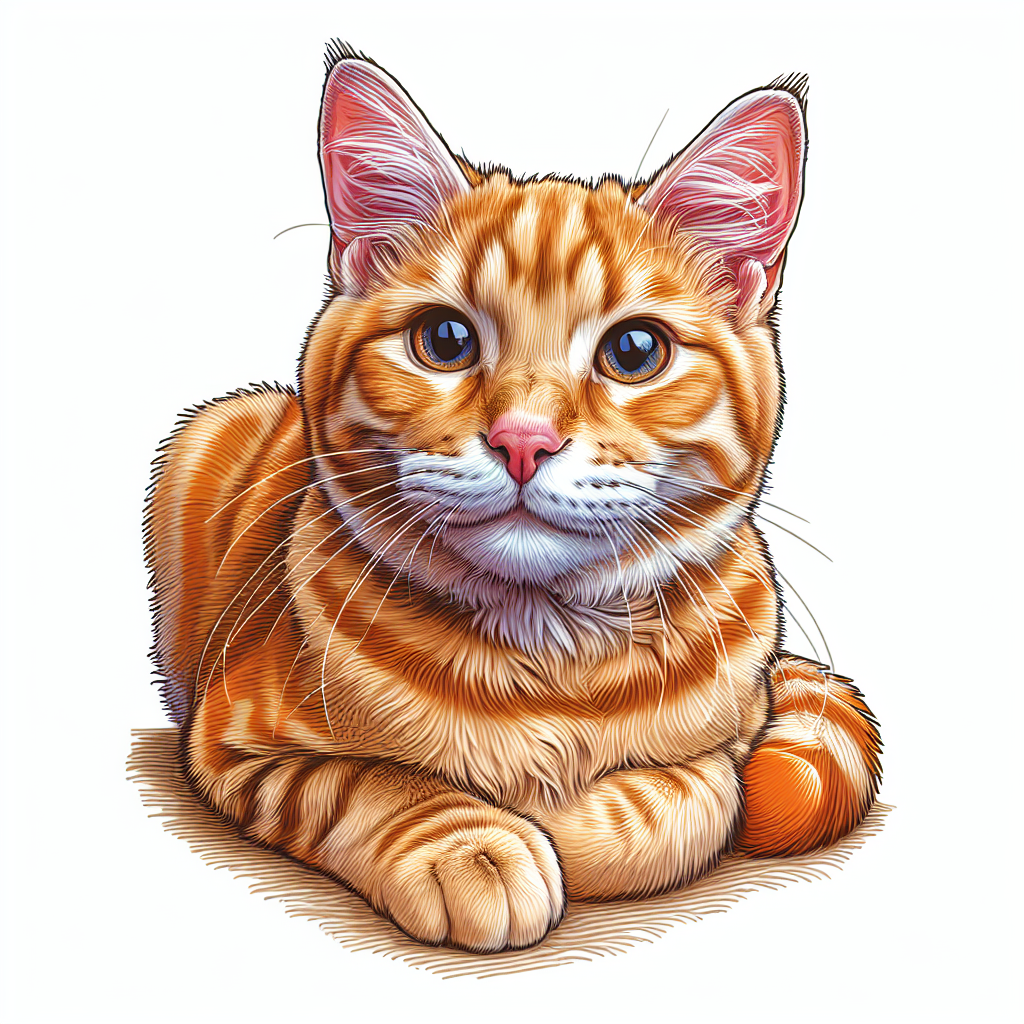When it comes to feline companions, one can’t help but wonder about the personalities of different cat breeds. Among them, orange tabby cats have garnered quite a reputation. Renowned for their striking color and endearing appearance, many are left curious about their friendliness towards humans. In this article, we shall explore the fascinating world of orange tabby cats and discover whether their vibrant coats are reflective of their sunny dispositions. So if you’ve ever encountered an orange tabby and pondered about their affability, read on to unravel the secrets behind these delightful feline companions.

Physical Characteristics of Orange Tabby Cats
Orange tabby cats, also known as marmalade or ginger cats, are renowned for their distinct physical characteristics. Their coat color, tabby patterns, eye color, body size, and life expectancy all contribute to their unique appearance.
Coat Color
The most prominent physical characteristic of orange tabby cats is their vibrant and rich coat color. They are predominantly orange, ranging from deep and dark shades to lighter and brighter hues. The intensity of their color may vary, with some cats having a solid, uniform orange coat, while others may display tabby patterns.
Tabby Patterns
Tabby patterns in orange tabby cats go beyond just their coat color. Along with their orange fur, they often have distinct dark stripes or swirls on their coat, creating a beautiful and eye-catching design. These tabby patterns can vary from classic tabby, where the stripes are more prominent, to mackerel tabby, where the stripes resemble narrow fishbones, or even spotted tabby, where spots rather than stripes dominate.
Eye Color
The eye color of orange tabby cats can vary, although the most common eye colors are green and amber. Some orange tabby cats may have blue or even heterochromic eyes, where each eye has a different color. This diversity in eye color adds to their unique charm and allure.
Body Size
In terms of body size, orange tabby cats are typically of medium to large build. They have muscular bodies and strong bone structures, giving them an imposing yet elegant appearance. Their physique allows them to engage in various physical activities, making them agile and playful companions.
Life Expectancy
The life expectancy of orange tabby cats is generally consistent with domestic cat averages. With proper care, a healthy orange tabby cat can live an average of 12 to 16 years, although some have been known to live well into their late teens or even early twenties. Factors such as genetics, diet, exercise, and regular veterinary care play a significant role in determining their lifespan.
Temperament of Orange Tabby Cats
Orange tabby cats are not only admired for their physical attributes but also for their delightful temperament. They exhibit a range of personality traits that make them beloved companions.
General Personality
Orange tabby cats are often described as affectionate, social, and outgoing. They tend to possess a friendly and approachable nature, making them wonderful companions for individuals and families alike. These cats are known to be sociable and enjoy spending time with their human family members.
Social Behavior
Unlike some cats that prefer solitude, orange tabby cats thrive on human interaction and enjoy being a part of the family unit. They are often described as extroverted and are known for their ability to adapt well to various social environments. Their friendly and sociable nature makes them great companions for those seeking a cat that enjoys engaging with people.
Playfulness
Orange tabby cats have remarkably playful dispositions. They possess a youthful energy and curiosity that often lasts well into their adult years. They enjoy interactive playtime, especially when it involves toys or activities that stimulate their natural hunting instincts. Providing them with engaging toys and opportunities for play ensures their exercise and mental stimulation needs are met.
Intelligence
Orange tabby cats are generally known to be intelligent animals. They are quick learners and can easily pick up on cues and commands. This intelligence makes them receptive to training and interactive play. It is recommended to provide mental stimulation through puzzle toys or food-dispensing toys to keep their minds engaged and active.
Affection
One of the endearing qualities of orange tabby cats is their affectionate nature. They often seek out physical contact and enjoy being petted, cuddled, and even held. Many orange tabby cats are known to be “lap cats” and are quite content to curl up on their owner’s lap for a cozy and comforting nap. Their loving nature fosters strong bonds with their human family members.
Independence
While orange tabby cats have a friendly and sociable nature, they also possess a degree of independence. They are generally confident and self-assured, which allows them to adapt well to new environments and situations. However, they still value their alone time and will appreciate having a designated space where they can retreat and recharge.
Interactions with Humans
Orange tabby cats exhibit various behaviors in their interactions with humans, shaping their relationships with their owners, strangers, children, and other pets.
Bonding with Owners
When it comes to bonding with their owners, orange tabby cats excel. They have a natural affinity for forming strong emotional connections and quickly establish themselves as cherished family members. Their loving and affectionate nature, combined with their loyalty and playful spirit, contributes to the deep bonds they form with their human companions.
Behavior Towards Strangers
Orange tabby cats are generally friendly and welcoming to strangers. While some cats may be reserved or cautious when meeting new people, orange tabby cats often display an open and curious nature. They are more likely to approach and engage with new faces, making them a welcoming presence in social situations and a joy to have around when guests visit.
Relationship with Children
Orange tabby cats are well-suited for households with children. They exhibit a patient and tolerant demeanor, making them excellent companions for energetic youngsters. Their playful nature and gentle disposition enable them to engage in interactive play with children, forging strong bonds and providing endless hours of entertainment. It is crucial, however, to teach children how to handle cats properly and with respect to ensure the well-being of both the child and the cat.
Compatibility with Other Pets
Orange tabby cats generally get along well with other pets, including dogs and other cats. Their friendly nature and adaptability make it easier for them to establish positive relationships with different animals. However, it is essential to introduce new pets slowly and gradually, allowing the orange tabby cat to adjust and become comfortable in any new social dynamics.
Orange Tabby Cats and Communication
Like all cats, orange tabby cats possess their own unique ways of communication, using vocalizations, body language, and their ability to understand human cues.
Vocalizations
Orange tabby cats, like many other cats, have a repertoire of vocalizations that they use to communicate their needs and desires. From the familiar meow to purring, chirping, and even trilling, each vocalization carries its own meaning. They may meow to seek attention, express hunger, or communicate displeasure. Paying attention to their vocal cues helps strengthen the bond between orange tabby cats and their human companions.
Body Language
Body language is a vital aspect of communication for orange tabby cats. They use various physical cues to express their emotions and intentions. For example, a raised tail indicates a friendly and approachable mood, while a puffed-up tail and arched back might indicate fear or aggression. Learning to read and respond to their body language enhances the understanding between humans and their orange tabby feline friends.
Understanding Human Cues
Orange tabby cats have a remarkable ability to understand human cues. They can pick up on subtle gestures, tone of voice, and facial expressions. This understanding enables them to respond to their owner’s needs and emotions, often displaying empathy and providing comfort. It is essential for humans to communicate clearly and positively with their orange tabby cats to foster a harmonious and mutually rewarding relationship.

Health and Well-being of Orange Tabby Cats
Ensuring the health and well-being of orange tabby cats is essential to their longevity and overall quality of life. Attention to common health issues, proper nutrition and diet, exercise and activity, grooming needs, and regular veterinary care are all vital components of their well-being.
Common Health Issues
Orange tabby cats, like any other cat, may be prone to certain health issues. These can include gastrointestinal problems, obesity, dental issues, and urinary tract problems. Regular veterinary check-ups are crucial to catch and address any potential health concerns early on. Maintaining a healthy diet, providing regular exercise, and practicing good dental hygiene are also essential for their long-term health.
Nutrition and Diet
Providing a well-balanced and nutritious diet is vital to the health of orange tabby cats. A diet that includes high-quality protein, essential vitamins and minerals, and proper hydration helps support their overall well-being. It is recommended to consult with a veterinarian to determine the appropriate diet plan and portion sizes for an orange tabby cat based on their age, weight, and specific nutritional needs.
Exercise and Activity
Orange tabby cats benefit greatly from regular exercise and physical activity. Engaging them in play sessions that mimic their natural hunting instincts helps keep them mentally stimulated and physically fit. Interactive toys, puzzle feeders, and dedicated playtime with their owners are excellent ways to meet their exercise needs while fostering a strong bond.
Grooming Needs
The grooming needs of orange tabby cats are generally moderate. Regular brushing helps maintain their coats, keeping them clean and reducing shedding. Additionally, periodic nail trims and dental hygiene care contribute to their overall well-being. It is important to establish grooming routines early on to familiarize them with the process and make it a positive experience.
Veterinary Care
Regular veterinary care is crucial for the health and well-being of orange tabby cats. Routine check-ups, vaccinations, parasite prevention, and dental cleanings are all part of maintaining their overall health. In addition, it is important to monitor their weight, behavior, and appetite closely, as any significant changes may indicate underlying health issues that require prompt attention.
Training and Discipline for Orange Tabby Cats
Training and discipline are essential aspects of ensuring a well-behaved and happy orange tabby cat. Basic training commands, litter box training, scratching post training, and appropriate discipline techniques contribute to a harmonious coexistence.
Basic Training Commands
Orange tabby cats are intelligent and capable of learning basic training commands. Teaching them commands like sit, stay, and come can help establish boundaries and reinforce positive behaviors. Utilizing positive reinforcement techniques such as treats and praise while training encourages their responsiveness and helps strengthen the bond between cat and owner.
Litter Box Training
Litter box training is a vital aspect of responsible cat ownership. Orange tabby cats typically adapt well to litter box training, especially when provided with a clean and easily accessible litter box. It is essential to establish a consistent routine, use the appropriate litter type, and ensure proper cleanliness to encourage proper litter box habits.
Scratching Post Training
Training orange tabby cats to use a scratching post is essential for protecting furniture and maintaining their physical and mental well-being. Encouraging them to use a scratching post by providing positive reinforcement, such as treats or interactive play, helps redirect their natural scratching instincts. Placing the scratching post in an easily accessible and appealing location increases the likelihood of them using it regularly.
Discipline Techniques
Discipline for orange tabby cats should focus on positive reinforcement and redirection rather than punishment. Utilizing techniques such as ignoring undesired behaviors, providing alternative activities, and using deterrents, if necessary, helps shape their behavior in a humane and effective manner. It is important to remember that consistency and patience are key elements in training and discipline.
Environmental Considerations
Creating a suitable and enriching environment is crucial for the overall well-being of orange tabby cats. Considerations such as living space requirements, indoor vs. outdoor living, providing enrichment, and implementing safety precautions all contribute to their safety and happiness.
Living Space Requirements
Orange tabby cats require sufficient living space to move around comfortably. Providing them with a cat-friendly environment that includes vertical spaces, such as cat trees or shelves, allows them to engage in natural behaviors like climbing and observing their surroundings. Access to windows or outdoor enclosures can also help satisfy their desire for environmental exploration.
Indoor vs. Outdoor
The decision to keep an orange tabby cat indoors or allow outdoor access should be made with careful consideration. While some owners opt for supervised outdoor access or enclosed outdoor spaces, others choose to keep their cats indoors for safety reasons. Indoor environments can be enriched with interactive toys, scratching posts, and interactive play sessions to ensure their physical and mental stimulation needs are met.
Providing Enrichment
Enrichment is essential for the happiness and well-being of orange tabby cats. Providing a variety of toys, scratching surfaces, and interactive playtime helps prevent boredom and destructive behaviors. Rotating toys, using puzzle feeders, and engaging in interactive play sessions with their owners are effective ways to keep them mentally and physically engaged.
Safety Precautions
Implementing safety precautions is crucial to protect orange tabby cats from potential hazards. This includes securing windows and balconies, using pet-friendly plants, and keeping toxic substances out of their reach. Additionally, ensuring they have proper identification, such as microchipping or collar tags, contributes to their safety and increases the chances of a happy reunion if they were to become lost.
Famous Orange Tabby Cats
Throughout history and popular culture, several orange tabby cats have captured the hearts and imaginations of millions with their charming personalities and lovable antics. Here are a few famous examples:
Garfield
As one of the most well-known orange tabby cats, Garfield has become an iconic character in comics and cartoons. Known for his love of lasagna and knack for sarcasm, Garfield has brought joy to countless fans around the world with his humorous adventures.
Hobbes
Hobbes, from the beloved comic strip “Calvin and Hobbes,” is a loyal and wisecracking tiger-striped orange tabby. As the imaginary friend and companion to the mischievous Calvin, Hobbes is known for his witty comebacks and philosophical conversations.
Morris
Morris the Cat, the finicky spokescat for 9Lives cat food, is a famous orange tabby who won the hearts of millions with his charming personality and discerning taste buds. Morris appeared in numerous commercials and print advertisements, leaving an indelible mark on popular culture.
Bob
Bob the Street Cat, a real-life orange tabby, rose to fame through his heartwarming story documented in the book and subsequent film, “A Street Cat Named Bob.” Bob’s incredible bond with his owner, James Bowen, captured the hearts of readers and viewers worldwide, highlighting the positive impact cats can have on human lives.
Puss in Boots
Although a fictional character from the “Shrek” franchise, Puss in Boots is a swashbuckling and charismatic orange tabby cat who quickly became a fan-favorite. Known for his charming Spanish accent and impressive sword skills, Puss in Boots stole the show with his fearless yet endearing personality.
Myths and misconceptions about Orange Tabby Cats
Despite their friendly nature, there are some common myths and misconceptions surrounding orange tabby cats that are worth addressing.
Aggressiveness
Contrary to popular belief, orange tabby cats are not inherently aggressive. Like any cat, their behavior and temperament are influenced by various factors, including early socialization, individual personality, and environmental factors. With proper care, socialization, and training, orange tabby cats can be as gentle and affectionate as any other cat.
Stubbornness
Another misconception is that orange tabby cats are stubborn or difficult to train. While every cat has its own personality, orange tabby cats are generally intelligent and willing to learn. With positive reinforcement training techniques, patience, and consistency, they can be just as trainable as any other breed or color of cat.
Laziness
Orange tabby cats, like any other cats, have their own unique energy levels and activity preferences. While some individuals may be more laid-back and enjoy lounging, others may display higher levels of playfulness and energy. It is important to provide appropriate outlets for their physical and mental stimulation needs to prevent boredom and unwanted behaviors.
Conclusion
Orange tabby cats are not only visually striking but also possess a delightful temperament that makes them wonderful companions. Their physical characteristics, including coat color, tabby patterns, eye color, body size, and life expectancy, add to their unique charm. Known for their sociable and friendly nature, orange tabby cats form strong bonds with their owners, get along well with other pets, and interact positively with children. Through vocalizations, body language, and their ability to understand human cues, they effectively communicate their needs and desires. Maintaining their health and well-being involves attention to common health issues, a balanced diet, regular exercise, grooming needs, and veterinary care. Training and discipline techniques can shape their behavior, while providing a suitable living environment ensures their safety and happiness. Despite myths and misconceptions, orange tabby cats are friendly and loving creatures that bring joy and companionship to the lives of those fortunate enough to share their homes with them.

